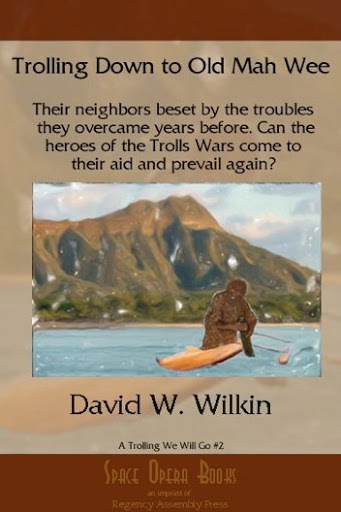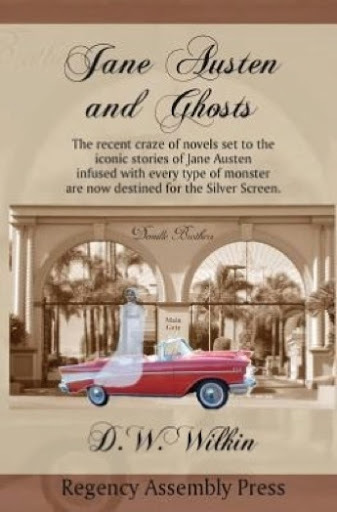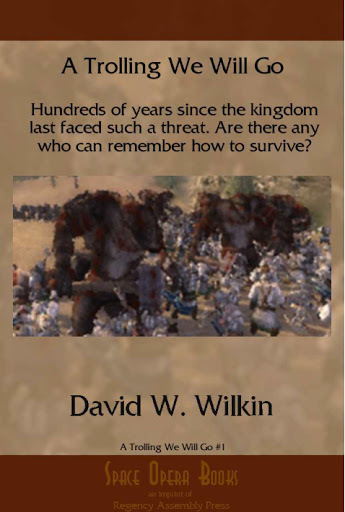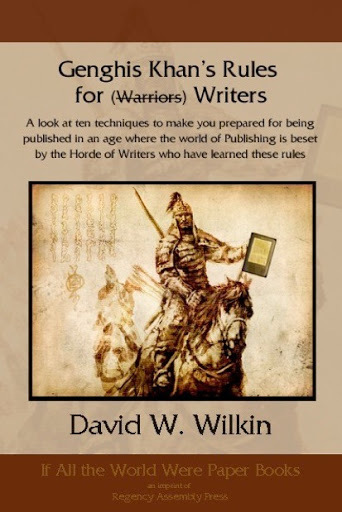D.W. Wilkin's Blog, page 38
July 26, 2016
Trolling Down to Old Mah Wee, another Fantasy
Trolling Down to Old Mah Wee
Not only do I write Regency and Romance, but I also have delved into Fantasy.
The Trolling series, (the first three are in print) is the story of a man, Humphrey. We meet him as he has left youth and become a man with a man’s responsibilities. We follow him in a series of stories that encompass the stages of life.
We see him when he starts his family, when he has older sons and the father son dynamic is tested. We see him when his children begin to marry and have children, and at the end of his life when those he has loved, and those who were his friends proceed him over the threshold into death.
All this while he serves a kingdom troubled by monsters. Troubles that he and his friends will learn to deal with and rectify. It is now available in a variety of formats.
For $2.99 you can get this 2nd book in the fantasy adventure series of Humphrey and Gwendolyn.
Barnes and Noble for your Nook
When the neighboring kingdom of Mah Wee begins to experience the same problems that beset Torahn some years before, they urgently request the aid of the experts in containing a new Troll infestation. But eradicating Trolls is not as easy as exterminating a few rats or mice.
Trolls are bigger than men, they are stronger than men, and then are meaner than men. Humphrey Cutter and his band of mismatched warriors must once again rise to the occasion, but can they without the aid of expertise of Gwendolyn and her particular skills?
Mah Wee, an ancient kingdom, with a monarch more steeped in the rights of being a king rather than the obligations and duties that a king should be. Here Humphrey and his crew finds that they have more than Trolls to overcome if they are to save Mah Wee from the same or nearly similar problems that they faced before in Torahn.
But, as Humphrey knows, nothing can truly be accomplished if the lovely Gwendolyn is not able to lend her aid as well.
Feedback
If you have any commentary, thoughts, ideas about the book (especially if you buy it, read it and like it
July 25, 2016
Regency Personalities Series-Francis (Leveson-Gower) Egerton 1st Earl of Ellesmere
Regency Personalities Series
In my attempts to provide us with the details of the Regency, today I continue with one of the many period notables.
Francis (Leveson-Gower) Egerton 1st Earl of Ellesmere
1 January 1800 – 18 February 1857
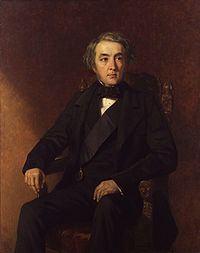
Francis (Leveson-Gower) Egerton
Francis (Leveson-Gower) Egerton 1st Earl of Ellesmere was the second son of George Leveson-Gower, 1st Duke of Sutherland and his wife, Elizabeth Gordon suo jure 19th Countess of Sutherland. He was born at 21 Arlington Street, Piccadilly, London, on 1 January 1800, and educated at Eton and Christ Church, Oxford.
Egerton entered Parliament in 1822 as member for the pocket borough of Bletchingley in Surrey, a seat he held until 1826. He afterwards sat for Sutherland between 1826 and 1831, and for South Lancashire between 1835 and 1846. In politics he was a moderate Conservative of independent views, as was shown by his support for the proposal to establish a University of London, also by making and carrying a motion for the endowment of the Roman Catholic clergy in Ireland, and by advocating free trade long before Sir Robert Peel yielded on the question. Appointed a Lord of the Treasury in 1827, he held the post of Chief Secretary for Ireland from 1828 till July 1830, when he became Secretary at War for a short time during the last Tory ministry.
In 1833 he assumed, by Royal Licence, the surname of Egerton, having succeeded on the death of his father to the estates which the latter inherited from the Francis Egerton, 3rd Duke of Bridgewater. In 1846 he was raised to the peerage as Earl of Ellesmere, of Ellesmere in the County of Salop, with the subsidiary title Viscount Brackley, of Brackley in the County of Northampton.
Ellesmere was a member of the Canterbury Association from 27 March 1848. In 1849, the chief surveyor of the Canterbury Association, Joseph Thomas, named Lake Ellesmere in New Zealand after him.
Ellesmere’s claims to remembrance are founded chiefly on his services to literature and the fine arts. Before he was twenty he printed for private circulation a volume of poems, which he followed up after a short interval by the publication of a translation of Goethe’s Faust, one of the earliest that appeared in England, with some translations of German lyrics and a few original poems. In 1839 he visited the Mediterranean and the Holy Land. His impressions of travel were recorded in Mediterranean Sketches (1843) and in the notes to a poem entitled The Pilgrimage. He published several other works in prose and verse. His literary reputation secured for him the position of rector of the University of Aberdeen in 1841.
A singular exception to the artistic and literary character of Ellesmere’s writing efforts lay in the field of military theory. Ellesmere, as a protegé of the Duke of Wellington, became very interested in the historical writings of the Prussian military theorist General Carl von Clausewitz (1789-1831). He was involved in the discussion that ultimately compelled Wellington to write an essay in response to Clausewitz’s study of the Waterloo campaign of 1815. Ellesmere himself anonymously published a translation of Clausewitz’s The Campaign of 1812 in Russia (London: J. Murray, 1843), a subject in which Wellington was also deeply interested.
Lord Ellesmere was a munificent and yet discriminating patron of artists. To the collection of pictures which he inherited from his great-uncle, the 3rd Duke of Bridgewater, he made numerous additions, and he built a gallery to which the public were allowed free access. Lord Ellesmere served as president of the Royal Geographical Society and as president of the Royal Asiatic Society (1849–1852), and he was a trustee of the National Gallery. He also initiated the collection of the National Portrait Gallery, by donating the Chandos portrait of Shakespeare.
On 18 June 1822, he married Harriet Catherine Greville, a great-great-granddaughter of the 5th Baron Brooke. They had eleven children, including:
George Egerton, 2nd Earl of Ellesmere (15 June 1823 – 19 September 1862);
Hon. Francis Egerton (15 September 1824 – 15 December 1895), who became an admiral, and was a Member of Parliament for two constituencies; he married in 1865 (Lady) Louisa Caroline née Cavendish, daughter of the 7th Duke of Devonshire (by marriage); they had issue;
Hon. Algernon Fulke Egerton (31 December 1825 – 14 July 1891), who was a Member of Parliament for three constituencies, and married in 1863 Hon. Alice Louisa Cavendish, a niece of the 7th Duke of Devonshire; they had issue;
Hon. Arthur Frederick Egerton (6 February 1829 – 25 February 1866), who became Lieutenant-Colonel, and married in 1858 Helen Smith, daughter of Martin Tucker Smith and his wife, Louisa Ridley; they had issue;
Lady Alice Harriot Frederica Egerton (10 October 1830 – 22 December 1928), who married George Byng, 3rd Earl of Strafford in 1854; they had no issue;
Lady Blanche Egerton (22 February 1832 – 20 March 1894), who married John Montagu, 7th Earl of Sandwich in 1865 as his second wife; they had no issue;
Hon. Granville Egerton (c. 1834-1851), who was killed at sea; unmarried, seemingly no issue.
The family lived at Hatchford Park, Cobham, Surrey, where Lady Ellesmere laid out the gardens. Her mother, Lady Charlotte Greville (née Cavendish-Bentinck) died at Hatchford Park on 28 July 1862, aged 86.
Francis died on 18 February 1857 at his London home, Bridgwater House, St. James’ Park; and was succeeded by his first son, George. On the extinction of the senior line of the Dukedom of Sutherland in 1963, his great-great-grandson, the fifth Earl, succeeded as 6th Duke of Sutherland.


Jane Austen Fans Rejoice, Jane is BACKKKK… Jane Austen and Ghosts
Special Sale Price!
Jane Austen and Ghosts.
Not only do I write Regency and Romance, but this can take a humorous turn. Some years back, I am sure readers of this blog will be aware that some writers began to take great liberty with Jane Austen and her works. Pride and Prejudice being liberally rewritten with the inclusion of zombies.
Then other books appeared with sea monsters, and werewolves and vampires. President Lincoln has even made it to the big screen where he is intent on sending foul creatures to hell. It occurred to me, even before I read any of this literature, that Jane would probably not appreciate what had been done to her classic piece.
That the tales and her life have become visual spectacles that we enjoy she might not like either, but is perhaps resigned to. That zombies, ghosts and vampires are now used to follow her own plot lines would I think, have her turning over in her grave. Jane Austen and Ghosts is my take on that.
It is now available in a variety of formats. For a limited time it has been reduced to $2.99 for your eReaders and $8.99 for paperback you can get this Jane Austen adventure.
Barnes and Noble for your Nook
and in Paperback
In the world of moviemaking, nothing is as golden as rebooting a classic tale that has made fortunes every time before when it has been adapted for the silver screen.
Certainly any work by Jane Austen made into a movie will not only be bankable, but also considered a work of art. That is of course until the current wave of adaptations that unite her classic stories with all the elements of the afterlife is attempted to be created.
That these have found success in the marketplace amongst booklovers may not be quite understood by those who make movies. But that they are a success is understood and a reason to make them into movies.
All that being said, perhaps it would also be fair to say that the very proper Jane, were she present to have anything to say about it, would not be pleased. Of course she has been away from this Earth for nearly 200 hundred years.
But does that mean were she upset enough, she wouldn’t come back?
Feedback
If you have any commentary, thoughts, ideas about the book (especially if you buy it, read it and like it
July 24, 2016
Regency Personalities Series-Thomas Hyde Villiers
Regency Personalities Series
In my attempts to provide us with the details of the Regency, today I continue with one of the many period notables.
Thomas Hyde Villiers
24 January 1801 – 3 December 1832
Thomas Hyde Villiers was the second son of George Villiers (1759–1827), who married, on 17 April 1798, Theresa, only daughter of John Parker, 1st Baron Boringdon. George William Frederick Villiers, 4th Earl of Clarendon was their eldest son, Charles Pelham Villiers their third son, and Henry Montagu Villiers their fifth son.
Thomas Villiers was educated at home; he was then sent with his eldest brother to St. John’s College, Cambridge. There he mixed with Charles Austin, Edward Strutt, John Romilly, Thomas Babington Macaulay, and others, most of them followers of Jeremy Bentham. In 1822 he graduated B.A., and in 1825 he proceeded M.A. On taking his degree in 1822 he entered the colonial office, where Sir Henry Taylor became early in 1824 his subordinate and then a close friend. The brothers lived during the earlier years of their lives with their parents in a part of Kent House in Knightsbridge, but from 1825 Thomas Hyde Villiers and Taylor shared a house in Suffolk Street.
Villiers joined in 1825 a debating club called “The Academics”, where several of his college friends and John Stuart Mill discussed political and economic topics. A speech of his, aon colonisation, attracted the attention of the chancellor of the exchequer. Not long afterwards Villiers gave up government service to embark on politics. His chief source of income at that point was from the agencies for Berbice and Newfoundland.
At the general election in June 1826 Villiers was returned to parliament for the borough of Hedon in Yorkshire, and sat for it until the dissolution in 1830. In 1830 and 1831 he sat respectively for Wootton Bassett (a family borough) and Bletchingley, and voted for the Reform Bill.
Villiers travelled in Ireland in 1828, and set out his views in long letters to Taylor. A letter written by him in February 1829 was shown to Richard Lalor Sheil, who then brought about the suppression of the Catholic Association. He suggested in 1831 the formation of the commission that laid the foundation of the new poor law, and assisted in its preliminary inquiries. On 18 May 1831 he became secretary to the board of control under Charles Grant. Later in the year (2 November 1831) Villiers and Taylor entered as students at Lincoln’s Inn. On 22 August 1831 he made a long speech in the House of Commons on the Methuen treaty with Portugal. The committees on Indian affairs were organised by Villiers, with the assistance of Lord Althorp. The renewal of the charter to the East India Company at this time preoccupied him.
At the time of his death Villiers was a candidate for the constituency of Penryn and Falmouth in Cornwall. After three months’ suffering from an abscess in the head, he died on 3 December 1832 at Carclew, the seat of Sir Charles Lemon, near Penryn, where he was staying. A monument was placed to his memory in Mylor church.


RAP (Regency Assembly Press) in need of Beta-Readers
Regency Assembly
Press
is looking for
Beta Readers
One novel is ready for Beta Reading
We have a continuation of Pride and Prejudice with Ms Caroline Bingley and her fortune at stake:
Do we think that Mr Hurst married his Bingley Bride without incentive? It is highly probable that Caroline Bingley, even though she has a sharp, acerbic tongue, still is in possession of a fortune and an astute fortune hunter who deciphers this may soon be on the road to, if not a happy marriage, one with financial security.
Please respond or send an email if you are interested


Space Opera Books Presents A Trolling We Will Go (Book #1)
A Trolling We Will Go
Not only do I write Regency and Romance, but I also have delved into Fantasy.
The Trolling series, (the first three are in print) is the story of a man, Humphrey. We meet him as he has left youth and become a man with a man’s responsibilities. We follow him in a series of stories that encompass the stages of life.
We see him when he starts his family, when he has older sons and the father son dynamic is tested. We see him when his children begin to marry and have children, and at the end of his life when those he has loved, and those who were his friends proceed him over the threshold into death.
All this while he serves a kingdom troubled by monsters. Troubles that he and his friends will learn to deal with and rectify.
It is now available in a variety of formats. For $.99 you can get this fantasy adventure.
Barnes and Noble for your Nook
The Valley Kingdom of Torahn had been at peace for fifty years since the Council of Twenty-One saw fit to dispense with their royal family.
The only Kingdom without a King on the west side of the continent. But late last year, something caused the Goblins in the Old Forest, Karasbahn to stir and act courageous.
Something that men can not remember seeing Goblins ever doing. What has gotten the Goblins in such a state?
Whatever it is, it can not be good news for Torahn. Or for Humphrey, a woodcutter for a small town, far from Karasbahn.
But part of the Kingdom’s militia, with no family or other exemptions. He is perfect to be sent to the Old Forest and find out what scares the Goblins that they have become fearless.
Feedback
If you have any commentary, thoughts, ideas about the book (especially if you buy it, read it and like it
July 23, 2016
Regency Personalities Series-Sir John Hamilton 1st Baronet of Woodbrook
Regency Personalities Series
In my attempts to provide us with the details of the Regency, today I continue with one of the many period notables.
Lieutenant General Sir John Hamilton 1st Baronet of Woodbrook
4 August 1755 – 24 December 1835
Sir John Hamilton 1st Baronet of Woodbrook was a highly respected and experienced officer of the Honourable East India Company, the British Army and during the Napoleonic Wars the Portuguese Army who saw action across the world from India to the West Indies and was honoured for his service by both the British and Portuguese royal families. Of noble Irish descent, related by birth to the first Earl Castle Stewart and by marriage to the Earl of Tyrone, Hamilton’s extensive career and brave service was widely recognised during his life and after his death.
John Hamilton was born in Woodbrook near Strabane, County Tyrone, Ireland to James and Elinor Hamilton in 1755. His mother was the niece of the Earl Castle Stewart and through family connections young Hamilton was able to secure a commission in the army of the Honourable East India Company aged only 16 in 1771. Taking a Bengal cadetship and joining the Bengal Light Infantry in 1772, Hamilton was almost immediately pressed into action, participating the British invasion of Cooch Behar at the invitation its rulers who were facing a simultaneous invasion from the Bhutanese to the north. In 1778 Hamilton was promoted to lieutenant and in 1780 was once again in action during the First Anglo-Maratha War, where his troops participated in the storm and capture of Lahar, Gwalior and Bijaigarh from the Maratha Empire. In 1781 at the war’s conclusion, Hamilton was promoted again, to captain.
In 1788, seeking advancement, Hamilton transferred to the regular British Army, being attached to the new 76th Regiment of Foot in Calcutta as captain. With this formation, Hamilton was engaged in 1794 during the Second Mysore War fought against the Tipu Sultan, when his troops captured the city of Bangalore which later became part of British East India. The same year, Hamilton married Emily Sophia Monck, the daughter of George Paul Monck and Lady Aramita Beresford, daughter of Marcus Beresford, Earl of Tyrone. Hamilton was promoted to brevet major in the aftermath of this operation and in 1795 was sent as a lieutenant colonel with the 81st Regiment of Foot to the West Indies during the British attempt to capture San Domingo. The effort failed due to the ongoing Haitian Revolution, but Hamilton again distinguished himself during the campaign.
In 1798 Hamilton was sent to the Cape Colony in South Africa which had only recently been captured from the Dutch. There he and his regiment formed part of the garrison until the Peace of Amiens when he returned to Britain, briefly returning to the Cape at the fresh outbreak of the Napoleonic Wars in 1803 before being made a brigadier-general and appointed to the staff in Ireland. Tiring of working in Ireland, Hamilton volunteered in 1809 to be attached to the Portuguese Army, a formation shattered by the French invasion of 1808. In 1809 as he trained and organised a division of Portuguese infantry, Hamilton was promoted to major-general and in his new rank was made Inspector-General of Portuguese Infantry.
Hamilton was an efficient officer and with his division, attached himself to Sir Arthur Wellesley’s British army on campaign in 1810. In 1811 the Portuguese formation underwent its first major action at the Battle of Albuera, Hamilton’s division acting as a ready reserve and being called into the height of the battle to reinforce the Allied centre. Hamilton’s forces had in fact been drawn into the fight on the left of the Allied line and took some time to be extracted. In the aftermath of the battle, Hamilton’s troops were the steadiest and freshest available and immediately returned to the ultimately unsuccessful Second Siege of Badajoz. It has been said of Hamilton that he “evinced the utmost steadiness and courage” at Albuera.
Hamilton commanded the division until 1813, his troops seeing further action defending the town of Alba de Tormes against an army under Marshal Soult in November 1812. In 1813 after four years continuous campaigning, Hamilton was forced to return to England on sick leave and during his absence he was made a Knight Grand Cross of the Order of the Tower and Sword by the Portuguese monarchy and was knighted by the Prince Regent as well as being made honorary colonel of the 2nd Ceylon Regiment. Hamilton returned to his division in late 1813 and commanded them during the last of the fighting in the Peninsula War, seeing action at the Battle of Nivelle. Following the Peace of Fontainebleau, Hamilton returned to the British Army, was made lieutenant general in recognition of his service and placed in the quiet command of Duncannon Fort.
In December 1814, Hamilton was further rewarded with a baronetcy and retirement to his family estates. In 1823 he was made the Colonel-in-chief of 69th Regiment of Foot. He died in 1835 at Tunbridge Wells and was buried in Kensal Green Cemetery in London, survived by his wife, five daughters and son Sir John James Hamilton, 2nd Baronet.


Rules for better writing from Genghis Khan
The Rules for Writers
Those who follow me for a long time know that I also write in other fields aside from Regency Romance and the historical novels I do.
A little while ago, before the end of 2011 and the 2011 NaNoWriMo, (where I wrote the first draft of another Regency) I started work on a project about writing.
The premise was what one should think about when starting and working on a project. I came up with 10 rules to follow in a quest to become a writer and tackle that novel.
Here are The 10 Rules:
1) Read like a writer
2) Have a good story
3) Your work will be Thematic
4) Plot: The seven deadly ones
5) Characters will carry your tale, near and far
6) Words are your warriors
7) Stories are structured
8) All tales building to a Crescendo
9) Genghis edits history, shouldn’t you as well
10) Act like a writer
So it is now released. For $4.99 you can get this treatise on honing your skills.
Barnes and Noble for your Nook
Genghis Khan came from the Steppes of Mongolia, a family torn apart by neighboring tribes, to unite those tribes, or defeat them, and then conquer the greater part of the known world. His heirs would continue his conquest right to the edge of western society. The world feared the Mongols, and Genghis. Now, you can benefit, as a writer from the lessons he has to impart on how, with the changing world of publishing, you can perfect your work and write not only good material for this new age of book publishing. But can write great work for this new age. 10 simple lessons, and you will be on your way to conquering the bookshelves of the 21st century. This short book will have you learning all you really need to know to elevate your writing to the next level. These simple lessons will start you on the road to better writing as a member of the Horde in no time.
Feedback
If you have any commentary, thoughts, ideas about the book (especially if you buy it, read it and like it
July 22, 2016
Regency Personalities Series-Horticultural Society of London
Regency Personalities Series
In my attempts to provide us with the details of the Regency, today I continue with one of the many period notables.
Horticultural Society of London
1804-1861
Founded in 1804 in London, England, as the Horticultural Society of London, and gained its present name, Royal Horticultural Society, in a Royal Charter granted in 1861. The Royal Horticultural Society is the UK’s leading gardening charity and claims to be “the world’s largest gardening charity”. The RHS quotes its charitable purpose as “The encouragement and improvement of the science, art and practice of horticulture in all its branches”.
The creation of a British horticultural society was suggested by John Wedgwood (son of Josiah Wedgwood) in 1800. His aims were fairly modest: he wanted to hold regular meetings, allowing the society’s members the opportunity to present papers on their horticultural activities and discoveries, to encourage discussion of them, and to publish the results. The society would also award prizes for gardening achievements.
Wedgwood discussed the idea with his friends, but it was four years before the first meeting, of seven men, took place, on 7 March 1804 at Hatchards bookshop in Piccadilly, London. Wedgwood was chairman; also present were William Townsend Aiton (successor to his father, William Aiton, as Superintendent of Kew Gardens), Sir Joseph Banks (President of the Royal Society), James Dickson (a nurseryman), William Forsyth (Superintendent of the gardens of St. James’s Palace and Kensington Palace), Charles Francis Greville (a Lord of the Admiralty) and Richard Anthony Salisbury, who became the Secretary of the new society.
Banks proposed his friend Thomas Andrew Knight for membership. The proposal was accepted, despite Knight’s ongoing feud with Forsyth over a plaster for healing tree wounds which Forsyth was developing. Knight was President of the society from 1811–1838, and developed the society’s aims and objectives to include a programme of practical research into fruit-breeding.
The society published its proceedings as the Transactions of the Horticultural Society of London from 1807 to 1848.


An Unofficial Guide to how to win the Scenarios of Rollercoaster Tycoon 3
An Unofficial Guide to how to win the Scenarios of Rollercoaster Tycoon 3
I have been a fan of this series of computer games since early in its release of the very first game. That game was done by one programmer, Chris Sawyer, and it was the first I recall of an internet hit. Websites were put up in dedication to this game where people showed off their creations, based on real amusement parks. These sites were funded by individuals, an expense that was not necessarily as cheap then as it is now. Nor as easy to program then as it might be to build a web page now.
Prima Books released game guides for each iteration of the game, Rollercoaster Tycoon 1, Rollercoaster Tycoon 2 and Rollercoaster Tycoon 3 (RCT3) but not for the expansion sets. And unlike the first two works, the third guide was riddle with incorrect solutions. As I played the game that frustrated me. And I took to the forums that Atari, the game publisher hosted to see if I could find a way to solve those scenarios that the Prima Guide had written up in error. Not finding any good advice, I created my own for the scenarios that the “Official” Guide had gotten wrong.
Solutions that if you followed my advice you would win the scenario and move on. But if you followed the
“Official” version you would fail and not be able to complete the game. My style and format being different than the folks at Prima, I continued for all the Scenarios that they had gotten right as well, though my solutions cut to the chase and got you to the winner’s circle more quickly, more directly.
My contributions to the “Official” Forum, got me a place as a playtester for both expansions to the game, Soaked and Wild. And for each of these games, I wrote the guides during the play testing phase so all the play testers could solve the scenarios, and then once again after the official release to make changes in the formula in case our aiding to perfect the game had changed matters. For this, Atari and Frontier (the actual programmers of the game) placed me within the game itself.
And for the longest time, these have been free at the “Official” Forums, as well as my own website dedicated to the game. But a short time ago, I noticed that Atari, after one of its bankruptcies had deleted their forums. So now I am releasing the Guide for one and all. I have added new material and it is near 100 pages, just for the first of the three games. It is available for the Kindle at present for $2.99.
(Click on the picture to purchase)
Not only are all 18 Scenarios covered, but there are sections covering every Cheat Code, Custom Scenery, the famous Small Park Competition, the Advanced Fireworks Editor, the Flying Camera Route Editor which are all the techniques every amusement park designer needs to make a fantastic park in Rollercoaster Tycoon 3.
Scenarios for RCT 3
1) Vanilla Hills
2) Goldrush
3) Checkered Flag
4) Box Office
5) Fright Night
6) Go With The Flow
7) Broom Lake
8) Valley of Kings
9) Gunslinger
10) Ghost Town
11) National Treasure
12) New Blood
13) Island Hopping
14) Cosmic Crags
15) La La Land
16) Mountain Rescue
17) The Money Pit
18) Paradise Island



